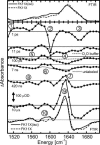Alpha-helix formation in a photoswitchable peptide tracked from picoseconds to microseconds by time-resolved IR spectroscopy
- PMID: 15699340
- PMCID: PMC548979
- DOI: 10.1073/pnas.0406948102
Alpha-helix formation in a photoswitchable peptide tracked from picoseconds to microseconds by time-resolved IR spectroscopy
Abstract
Photo-triggered alpha-helix formation of a 16-residue peptide featuring a built-in conformational photoswitch is monitored by time-resolved IR spectroscopy. An experimental approach with 2-ps time resolution and a scanning range up to 30 micros is used to cover all time scales of the peptide dynamics. Experiments are carried out at different temperatures between 281 and 322 K. We observe single-exponential kinetics of the amide I' band at 322 K on a time scale comparable to a recent temperature-jump folding experiment. When lowering the temperature, the kinetics become slower and nonexponential. The transition is strongly activated. Spectrally dispersed IR measurements provide multiple spectroscopic probes simultaneously in one experiment by resolving the amide I' band, isotope-labeled amino acid residues, and side chains. We find differing relaxation dynamics at different spectral positions.
Figures





Similar articles
-
Folding dynamics of the Trp-cage miniprotein: evidence for a native-like intermediate from combined time-resolved vibrational spectroscopy and molecular dynamics simulations.J Phys Chem B. 2013 Oct 3;117(39):11490-501. doi: 10.1021/jp404714c. Epub 2013 Sep 19. J Phys Chem B. 2013. PMID: 24050152
-
IR spectroscopy of isotope-labeled helical peptides: probing the effect of N-acetylation on helix stability.Biopolymers. 2000 Sep;54(3):180-5. doi: 10.1002/1097-0282(200009)54:3<180::AID-BIP40>3.0.CO;2-9. Biopolymers. 2000. PMID: 10861379
-
Folding and unfolding of a photoswitchable peptide from picoseconds to microseconds.Proc Natl Acad Sci U S A. 2007 Mar 27;104(13):5383-8. doi: 10.1073/pnas.0607748104. Epub 2007 Mar 19. Proc Natl Acad Sci U S A. 2007. PMID: 17372213 Free PMC article.
-
Helix formation via conformation diffusion search.Proc Natl Acad Sci U S A. 2002 Mar 5;99(5):2788-93. doi: 10.1073/pnas.052700099. Epub 2002 Feb 26. Proc Natl Acad Sci U S A. 2002. PMID: 11867741 Free PMC article.
-
Site-specific relaxation kinetics of a tryptophan zipper hairpin peptide using temperature-jump IR spectroscopy and isotopic labeling.J Am Chem Soc. 2008 Mar 12;130(10):2984-92. doi: 10.1021/ja074215l. Epub 2008 Feb 16. J Am Chem Soc. 2008. PMID: 18278908
Cited by
-
Effects of side chains in helix nucleation differ from helix propagation.Proc Natl Acad Sci U S A. 2014 May 6;111(18):6636-41. doi: 10.1073/pnas.1322833111. Epub 2014 Apr 21. Proc Natl Acad Sci U S A. 2014. PMID: 24753597 Free PMC article.
-
Microscopic nucleation and propagation rates of an alanine-based α-helix.Phys Chem Chem Phys. 2017 Feb 15;19(7):5028-5036. doi: 10.1039/c6cp08924k. Phys Chem Chem Phys. 2017. PMID: 28165082 Free PMC article.
-
All-atom model for stabilization of alpha-helical structure in peptides by hydrocarbon staples.J Am Chem Soc. 2009 Apr 8;131(13):4622-7. doi: 10.1021/ja805037p. J Am Chem Soc. 2009. PMID: 19334772 Free PMC article.
-
Exposing the Nucleation Site in α-Helix Folding: A Joint Experimental and Simulation Study.J Phys Chem B. 2019 Feb 28;123(8):1797-1807. doi: 10.1021/acs.jpcb.8b12220. Epub 2019 Feb 14. J Phys Chem B. 2019. PMID: 30694671 Free PMC article.
-
Alpha-Helix folding in the presence of structural constraints.Proc Natl Acad Sci U S A. 2008 Jul 15;105(28):9588-93. doi: 10.1073/pnas.0712099105. Epub 2008 Jul 9. Proc Natl Acad Sci U S A. 2008. PMID: 18621686 Free PMC article.
References
-
- Daniel, R. M., Dunn, R. V., Finney, J. L. & Smith, J. C. (2003) Annu. Rev. Biophys. Biomol. Struct. 32, 69-92. - PubMed
-
- Karplus, M. (2000) J. Phys. Chem. B 104, 11-27.
-
- Gruebele, M. (2002) Curr. Opin. Struct. Biol. 12, 161-168. - PubMed
-
- Ferguson, N. & Fersht, A. R. (2003) Curr. Opin. Struct. Biol. 13, 75-81. - PubMed
Publication types
MeSH terms
Substances
LinkOut - more resources
Full Text Sources

